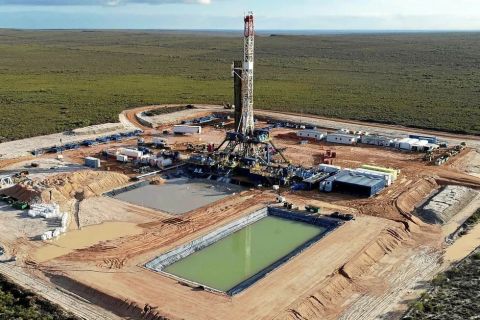
At the 23rd World Petroleum Congress held in Houston, Exxon Mobil CEO Darren Woods (top) and Chevron CEO Mike Wirth (bottom) detailed low-carbon strategies that included investment in innovation for renewables and fossil fuels, contrary to the consensus surrounding the path to net-zero emissions. (Source: Shutterstock.com/Hart Energy/CNBC)
HOUSTON—Oil and gas companies in the industry have rolled out a variety of measures to achieve their net-zero goals, however, top executives from Exxon Mobil Corp. and Chevron Corp. revealed plans that focus on advancements for both renewables and fossil fuels.
Innovation was the theme of the 23rd World Petroleum Congress (WPC), and accordingly, the CEOs of the two U.S. oil majors shared net-zero pathways that depend on both breakthroughs in low-carbon energy solutions and advancements to existing oil and gas infrastructure.
“Our industry can and should take a leading role in providing the products that enable modern life while developing the needed technologies and strategies to advance the lower-emissions future,” Darren Woods, chairman and CEO at Exxon Mobil, said during an opening session on Dec. 6. “It's imperative that we do both and strike the right balance today, while making improvements for tomorrow.”
Exxon Mobil: CCUS Innovation
Unlike its peers, Irving, Texas-based Exxon Mobil has yet to make a formal pledge, but revealed it was considering committing to net-zero carbon emissions by 2050, the Wall Street Journal reported in August. During the panel, Woods said the company would continue to develop fossil fuels, but will leverage its technical capabilities to achieve the largest emission reductions at the lowest cost to society.
“As the world transitions to a lower-carbon energy system, it’s critical to strike the right balance, ensuring that we continue to meet all the world’s essential needs,” Woods said. “The fact remains under most critical scenarios, including net-zero pathways, oil and natural gas will continue to play a significant role in meeting society’s needs.”
In February, Exxon Mobil launched its Low Carbon Solutions business to focus on carbon capture and storage (CCS) innovation. The business has announced concepts for several CCS hubs where high-emitting industries can share infrastructure, expertise and assets to create cost-effective solutions at scale.
Additionally, Exxon Mobil, along with 10 other companies, have supported a concept for the large-scale deployment of CCS technology in Houston.
“We believe a project like this could annually capture about 100 million metric tons of CO₂ from area refineries, chemical plants and power generation facilities by 2040. That’s equal to the greenhouse-gas (GHG) emissions from more than 20 million cars,” Woods said.
Exxon Mobil plans to invest more than $15 billion by 2027 on initiatives to lower GHG emissions in its operations and to grow its Low Carbon Solutions business, Woods said.
In Alberta, Canada, Canadian oil producer Imperial Oil Ltd. is working on a process that turns vegetable oil into renewable diesel at its 191,000-bbl/d Strathcona refinery. The success of the project will aid majority-owner Exxon Mobil (69.9% ownership) with its goal to produce more than 40,000 bbl/d of low-emissions fuels by 2025.
“We’re continuing to advance research with our university partners and other stakeholders to explore and commercialize additional biophilic technologies that don't compete with food sources,” he said.
Its effort will extend to its Permian Basin operations, where it intends to achieve net-zero emissions and eliminate flaring in the region by 2030.
“Our investments to electrify our operations in the region, coupled with our innovative work to identify and eliminate methane leaks and routine flaring puts us on this achievable path,” he said.
RELATED: Exxon Mobil Sets Net-zero Goal for Permian Basin Operations by 2030
Additionally, Exxon Mobil has placed a priority on sectors notoriously hard to decarbonize like commercial transportation and power generation, which account for more than 80% of the world’s CO₂ emissions in the industry.
Chevron: Sustainable Aviation Fuel, RNG
Similarly, San Ramon, Calif.-based Chevron is focusing its 140 years of expertise on progressing these massive sectors that will dictate the global transition to clean energy, according to chairman and CEO Mike Wirth.
“Our approach is straightforward: we’re accelerating progress toward a lower-carbon future by driving down the emissions intensity of our oil and gas production today and investing to develop lower-carbon energy solutions for tomorrow,” Wirth told WPC attendees on Dec. 6.
The aviation sector generates 11% of all U.S. transportation emissions, with total emissions growing at 4% to 5% per year. With major airlines are pushing for solutions, Chevron is developing technology to produce sustainable aviation fuel.
“Sustainable aviation fuel can reduce emissions up to 80% on a lifecycle basis compared to traditional jet fuel,” he said. “It’s compatible with modern aircraft engines and airport fueling infrastructure and we've already begun producing them in our Southern California refinery.”
In the agriculture space, Chevron’s partnership with California Bioenergy LLC (CalBio) and California dairy farmers has helped it successfully produce and market dairy biomethane as renewable natural gas. Essentially, it is using advanced technology to capture methane emitted to the atmosphere and turning it into a valuable fuel with a negative carbon intensity on a lifecycle basis under California standard.
“Developing and scaling additional solutions including hydrogen and carbon capture will enable more industries to join in the drive toward a lower-carbon future. These industries built modern society, and people around the world rely on them every day,” he said.
Like Woods, Wirth still sees the importance of oil and gas, pointing to the Biden’s administration recent request for OPEC to boost oil production and the International Energy Agency’s appeal to Russia to supply more natural gas to Europe.
“This reveals a fundamental truth that should inform any rational conversation about the future of energy: oil and gas will continue to play a central role in meeting the world’s energy needs,” he said.
However, the company still has a variety of projects underway to reduce the carbon intensity of the business including improving methane detection, rethinking facility designs, optimizing equipment, utilizing renewable power and deploying new operational practices.
In the Permian Basin, for example, Chevron has entered a partnership to build solar and wind power to support operations. The company expects this project to reduce its emissions in the region by 300,000 tonnes per year.
“Innovation will be critical to meeting the expanding energy needs of a growing world,” he said. “Breakthroughs will be needed, technologies must be developed and deployed, and global energy challenges must be solved on a massive scale."
Recommended Reading
Brett: Oil M&A Outlook is Strong, Even With Bifurcation in Valuations
2024-04-18 - Valuations across major basins are experiencing a very divergent bifurcation as value rushes back toward high-quality undeveloped properties.
Marketed: BKV Chelsea 214 Well Package in Marcellus Shale
2024-04-18 - BKV Chelsea has retained EnergyNet for the sale of a 214 non-operated well package in Bradford, Lycoming, Sullivan, Susquehanna, Tioga and Wyoming counties, Pennsylvania.
Triangle Energy, JV Set to Drill in North Perth Basin
2024-04-18 - The Booth-1 prospect is planned to be the first well in the joint venture’s —Triangle Energy, Strike Energy and New Zealand Oil and Gas — upcoming drilling campaign.
PGS, TGS Merger Clears Norwegian Authorities, UK Still Reviewing
2024-04-17 - Energy data companies PGS and TGS said their merger has received approval by Norwegian authorities and remains under review by the U.K. Competition Market Authority.
Energy Systems Group, PacificWest Solutions to Merge
2024-04-17 - Energy Systems Group and PacificWest Solutions are expanding their infrastructure and energy services offerings with the merger of the two companies.




